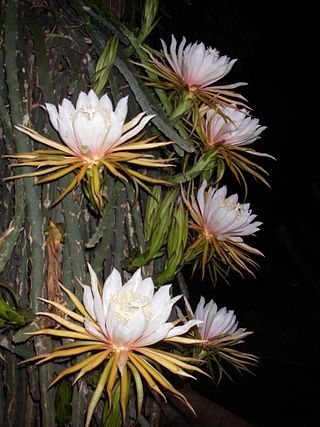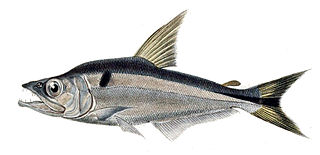
Catfish are a diverse group of ray-finned fish. Named for their prominent barbels, which resemble a cat's whiskers, catfish range in size and behavior from the three largest species alive, the Mekong giant catfish from Southeast Asia, the wels catfish of Eurasia, and the piraíba of South America, to detritivores, and even to a tiny parasitic species commonly called the candiru, Vandellia cirrhosa. Neither the armour-plated types nor the naked types have scales. Despite their name, not all catfish have prominent barbels or "whiskers". Members of the Siluriformes order are defined by features of the skull and swimbladder. Catfish are of considerable commercial importance; many of the larger species are farmed or fished for food. Many of the smaller species, particularly the genus Corydoras, are important in the aquarium hobby. Many catfish are nocturnal, but others are crepuscular or diurnal.

Characidae, the characids or characins is a family of freshwater subtropical and tropical fish, belonging to the order Characiformes. The name "characins" is the historical one, but scientists today tend to prefer "characids" to reflect their status as a by and large monophyletic group at family rank. To arrive there, this family has undergone much systematic and taxonomic change. Among those fishes that remain in the Characidae for the time being are the tetras, comprising the very similar genera Hemigrammus and Hyphessobrycon, as well as a few related forms such as the cave and neon tetras. Fish of this family are important as food and also include popular aquarium fish species.

Upwelling is an oceanographic phenomenon that involves wind-driven motion of dense, cooler, and usually nutrient-rich water from deep water towards the ocean surface. It replaces the warmer and usually nutrient-depleted surface water. The nutrient-rich upwelled water stimulates the growth and reproduction of primary producers such as phytoplankton. The biomass of phytoplankton and the presence of cool water in those regions allow upwelling zones to be identified by cool sea surface temperatures (SST) and high concentrations of chlorophyll a.

Fish migration is mass relocation by fish from one area or body of water to another. Many types of fish migrate on a regular basis, on time scales ranging from daily to annually or longer, and over distances ranging from a few metres to thousands of kilometres. Such migrations are usually done for better feeding or to reproduce, but in other cases the reasons are unclear.

The Amazon basin is the part of South America drained by the Amazon River and its tributaries. The Amazon drainage basin covers an area of about 7,000,000 km2 (2,700,000 sq mi), or about 35.5 percent of the South American continent. It is located in the countries of Bolivia, Brazil, Colombia, Ecuador, Guyana, Peru, Suriname, and Venezuela, as well as the territory of French Guiana.

Hylocereus is a former genus of epiphytic cacti, often referred to as night-blooming cactus. Several species previously placed in the genus have large edible fruits, which are known as pitayas, pitahayas or dragonfruits. In 2017, a molecular phylogenetic study confirmed an earlier finding that the genus Hylocereus was nested within Selenicereus, so all the species of Hylocereus were transferred to Selenicereus.

The brown catshark is commonly found in the Pacific Ocean, ranging from the northern Pacific waters off the coast of British Columbia and south to the Baja California peninsula in Mexico. They may live as far south as Ecuador and Peru. Brown catsharks are deep-water sharks that live on the outer continental shelf and the upper slope. They have been known to live at depths ranging from 30 to 650 m and live on the bottom, usually in muddy or sandy areas. The brown catshark, when originally described, was called Catulus brunneus.
Charax (Χάραξ) may refer to:

Charax is a genus containing several species of South American tetras, including the glass headstander, C. gibbosus. These fish, among other characteristics, are small and have a rhomboid shape. Some species are semi-translucent.

The blackspot shark is a small species of requiem shark in the family Carcharhinidae found in the tropical Indo-West Pacific Ocean between latitudes 24°N and 30°S, from the surface to a depth around 40 m (130 ft). Its length is a little under one meter (yard) and it is not considered to be dangerous to humans. It feeds mainly on fish, crustaceans, and squid. This shark is also caught in small-scale fisheries for human consumption.

The spotted houndshark, Triakis maculata, is a houndshark of the family Triakidae found in tropical waters in the eastern Pacific Ocean off the coast of South America. It usually grows to a length around 180 centimetres (71 in). The reproduction of this houndshark is ovoviviparous, with a litter of 14 pups being found in one female with a birth size of 30 to 40 centimetres. Their diet is believed to consist mainly of crustaceans.

The narrow-winged pipistrelle is a species of vesper bat. It can be found in Brunei Darussalam, Indonesia, and Malaysia.
Notobrachyops is a genus of brachyopid temnospondyl amphibian. It is known from a skull roof impression found in the Ashfield Shale of Mortdale, New South Wales, Australia. The Ashfield Shale has also yielded a shark species, a lungfish species, six species of paleoniscid fish, a species of holostean fish, a subholostean fish, and the labyrinthodont amphibian Paracyclotosaurus davidi.

Galeocharax is a genus of characins from the Río de la Plata and Amazon basins in South America. They reach up to 30.5 cm (1 ft) in length and mainly feed on other fish, but also take crustaceans and insects.

Stenopterus is a genus of beetles belonging to the family Cerambycidae, subfamily Cerambycinae. Species of this genus are present in most of Europe, in the Near East and in North Africa.

Ectrepopterus uruguayensis is a small species of characin originally recorded only from streams in Uruguay, with occasional sightings in Brazil and Argentina. It is the only known member of the genus Ectrepopterus, which was formerly a subgenus of Megalamphodus. Given its restricted range, it is considered a rare fish, and is of note for conservation researchers interested in preserving the biodiversity of the region.

Ikan goreng is a hot dish consisting of deep fried fish or other forms of seafood. Ikan goreng literally means "fried fish" in Indonesian and Malay languages.

The glass headstander,, is a species of fish in the genus Charax. commonly known as the transparent tetra.

Thoracocharax stellatus, the silver hatchetfish, spotfin hatchetfish, spotted hatchetfish or platinum hatchetfish, is a widespread hatchetfish found throughout South America including Venezuela, Colombia, Ecuador, Brazil, Peru, Bolivia, Paraguay, and Argentina in the Amazon, Orinoco, Paraguay and Tocantins-Araguaia basins. This species is one of the largest of the hatchetfishes. It is usually found in areas with abundant riparian vegetation.

















